China Newspeak
China's Political Discourse in 2019
In 2019, the most important change we saw in the political discourse of the Chinese Communist Party was the complete abandonment of the phrase “political system reform,” or zhengzhi tizhi gaige (政治体制改革). The process of political reform in China was jump-started in the 1980s by Deng Xiaoping (邓小平), Hu Yaobang (胡耀邦) and Zhao Ziyang (赵紫阳) between 1986 and 1988, and during this period the term “political system reform” actually became what we label a “hot” (热) phrase within the discourse heat scale I have developed with the discourse analysis team at the China Media Project.
The political reform wave – speaking here from a discourse standpoint – culminated with the first ever inclusion of the phrase “political system reform” in the political report to the 13th National Congress of the CCP in 1987. But ever since that time, we can say that the phrase has sputtered and sizzled, fading and returning, as it has progressively cooled within the overall discourse environment.
Since the 18th National Congress in 2012, which marked Xi Jinping’s rise to power, use of the phrase “political system reform,” already rare enough, has dropped off dramatically. And we now can say with some confidence that we are seeing the complete elimination of the term, a trend we noted at CMP back in October.
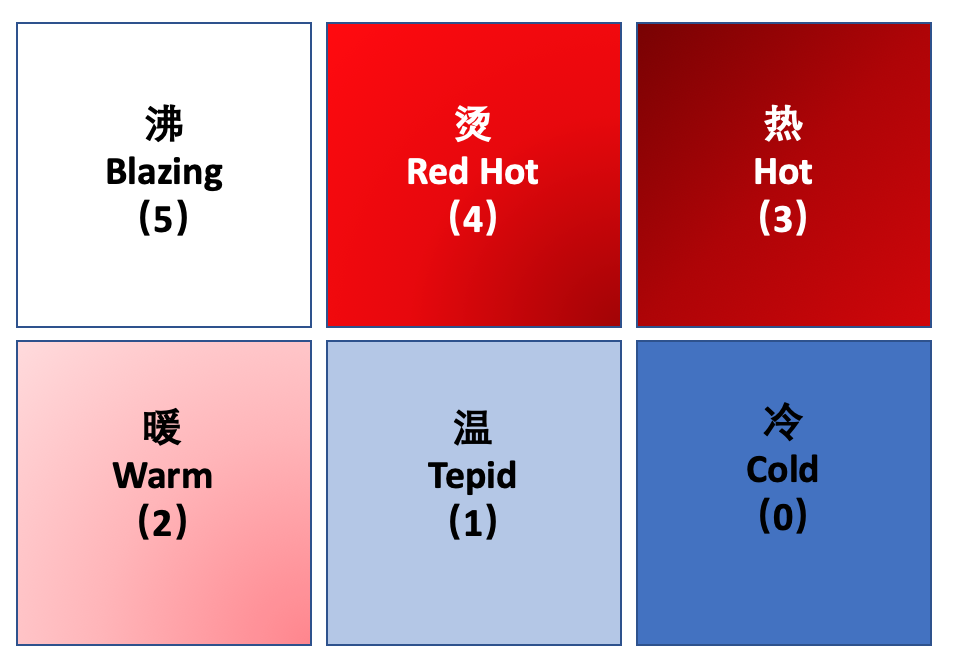
Below I’ll provide just a quick summary in English of the trends we saw in the Chinese political discourse in 2019, and then look at the key words used to discuss the economy and what these reveal about anxieties in the leadership. For our full discourse report, I refer readers to the Chinese-language version, which I’ve included in full further down.
The Blazing and the Red Hot
Using the index of political discourse terminologies and their “temperature” as developed by the China Media Project on the basis of frequency of use in the CCP’s official People’s Daily newspaper, we can note that in 2019 the following phrases stood out either for their intensity of use (“blazing” and “red hot” being the strongest intensities) or for their shift in temperature within the index.
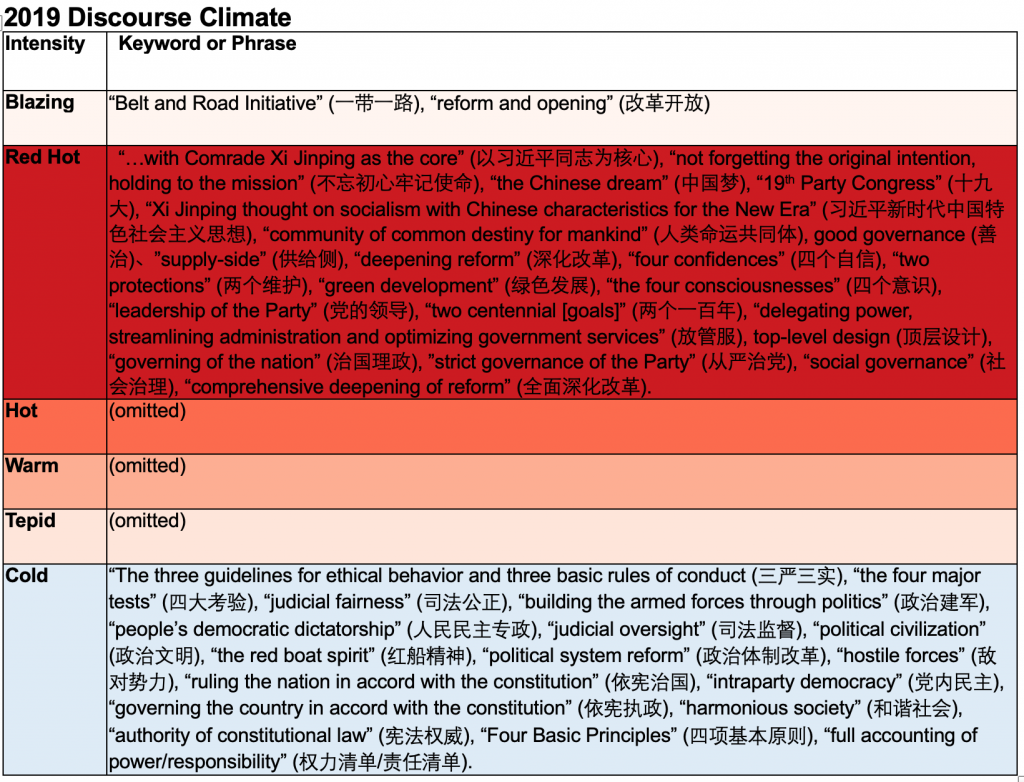
Compared to our study of discourse for 2018, the overall position of these terms and phrases shows little change. At the top of the chart, the biggest difference is that two of the four terms in the “blazing” category last year – namely, “19th National Congress” and “Xi Jinping thought on socialism with Chinese characteristics for the New Era” – have dropped into the “red hot” category for 2019. The Belt and Road Initiative and “reform and opening” top the charts this year, showing the greatest intensity of use in the People’s Daily on a per article basis.
In the “red hot” category, meanwhile, we have two new additions this year. These are the “two protections,” essentially protecting Xi as the “core” of the Party leadership and protecting the Party’s unified leadership, and that stay-the-course phrase so common this year, “not forgetting the original intention, holding to the mission.”
In 2018, the “two protections” joined the “four consciousnesses” and the “four confidences” to become standard phrases (规范用语) in the Party press. “Not forgetting the original intention, holding to the mission,” a phrase introduced during the 19th National Congress of the CCP in October 2017, became a “hot” phrase in 2018, rising in use in the People’s Daily. In 2019, the phrase rose further, entering the “red hot” category. The term “good governance” (善治), rose two levels in 2019, from “warm” to “red hot”.
In 2019, we have a handful of phrases that appeared in the “red hot” category in 2018 that dropped down to “hot.” These include the “village revival strategy” (乡村振兴战略), “innovation-driven” (创新驱动) and “administration in accord with the law” (依法治国).
Among the “cold” terms in 2019, we find “political civilization” (dropping two levels from “warm”), “ruling the nation in accord with the constitution” (dropping two levels from “warm”), “authority of constitutional law” (dropping two levels from “warm”), and “full accounting of power/responsibility” (dropping two levels from “warm”).
One result that may surprise, given official propaganda over perceived foreign meddling in Hong Kong, is that the phrase “hostile forces” (敌对势力) remained in the “cold” category in 2019. But this does not necessarily mean a drop in the use of related phrases, and in fact in the second half of the year we see a marked rise in these use of the term “external forces” (外部势力), which brought the term into the “hot” category.
The Economy
What does the political discourse in 2019 tell us about the economic situation?
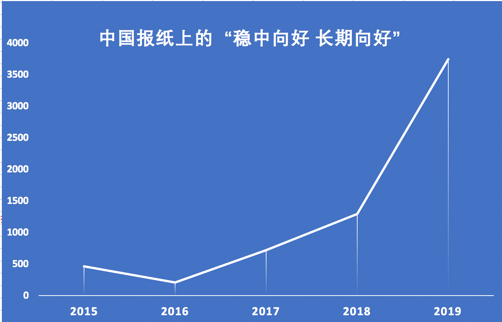
In 2019, we saw a dramatic rise in use of the phrase “steady improvement, long-term improvement” (稳中向好, 长期向好) in the official discourse, and broadly used across Chinese newspapers, based on our search of the – an indication that the authorities are keen to send a message that all is well.
But if we look beyond the Party-run newspapers and digital outlets, we see other indicators of economic concern. Here, for example, we see the dramatic rise in 2019 of the word “pig” in news headlines, reflecting the nationwide crisis over pork prices.
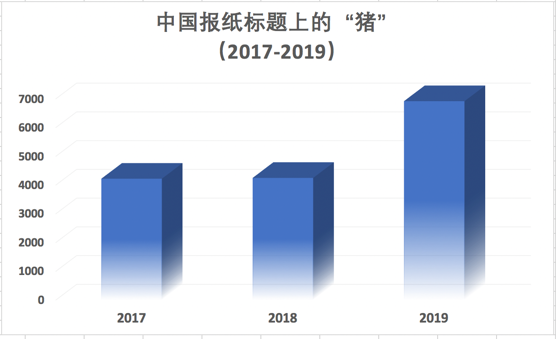
The increase in coverage seen in the above graph is driven by news about pork prices and supply shortages. While this is just one factor within the overall economy, it was without a doubt a source of anxiety for the leadership and a factor that undermined the sense that all was “steady” and “improving.”
When we look at the economic picture in China after the 19th National Congress in 2017, we can observe the term “economic downturn” (下行压力). This term experienced a peak back in 2015 but later declined. Here is how the term has looked in Chinese newspapers over the past three years.
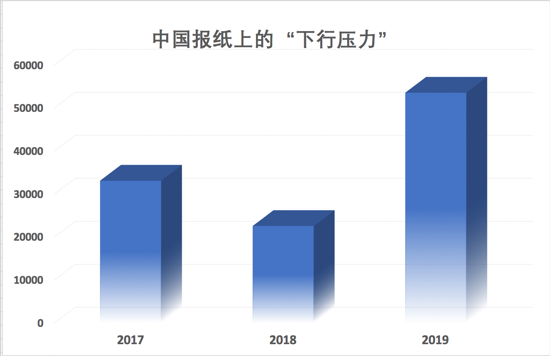
At the end of every year, the CCP’s Central Committee holds an important economic work conference that sends signals about economic sentiment and policy, though the language often requires a great deal of reading between the lines. Since 2012 there have been eight such work conferences, and here is the key language emerging from each, reflected in the official discourse played across Party media.
2012: “comprehensive deepening of economic system reforms” (全面深化经济体制改革)
2013: “keeping steady” (稳中求进)
2014: “new normal” (新常态)
2015: “supply-side” (供给侧)
2016: “new development concept” (新发展理念)
2017: “preventing and solving major risks” (防范化解重大风险)
2018: “steady employment, steady finance, steady foreign trade, steady investment, steady expectations” (稳就业、稳金融、稳外贸、稳外资、稳投资、稳预期) / “Six Steadies” (六稳)
2019: “Putting ‘steady’ first” (稳字当头)
When we review these eight terms we can note the diminishing sense of optimism over time, and a rising sense of crisis that is understated in the official discourse. “A new normal for the Chinese economy” was a phrase introduced when GDP growth in China was falling below the 8 percent level, the goal being to habituate Chinese to the idea that GDP growth between 7 and 8 percent was acceptable. The phrase “supply-side structural reforms,” meanwhile, was a way of coping with continued weakness, the goal being to regain momentum. Both “new normal” and “supply-side” rose rapidly to become “red hot” terms after their introduction. But in 2019, we have seen signs of fatigue for both terms when we look at use within the official People’s Daily on a per-article basis.

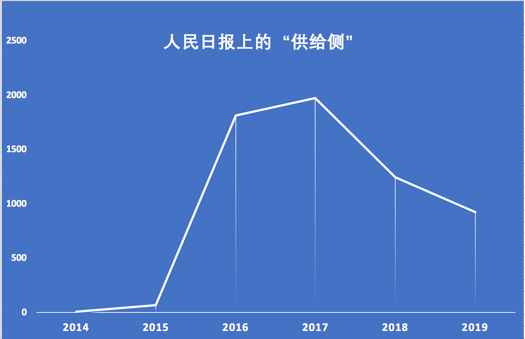
In 2019, we see “supply-side” maintaining its “red hot” status, but with significantly diminished use in the People’s Daily, about half the level of use recorded for 2017. The “new normal,” meanwhile, drops down to the “warm” category, understandable considering that the 7-8 percent GDP growth level it pointed to is no longer sustainable.
On October 19, 2019, the National Bureau of Statistics released the latest GDP estimates, which drew a great deal of attention globally. GDP growth came in at what Deutsche Welle and other news outlets referred to as an “underwhelming” 6 percent for the quarter.
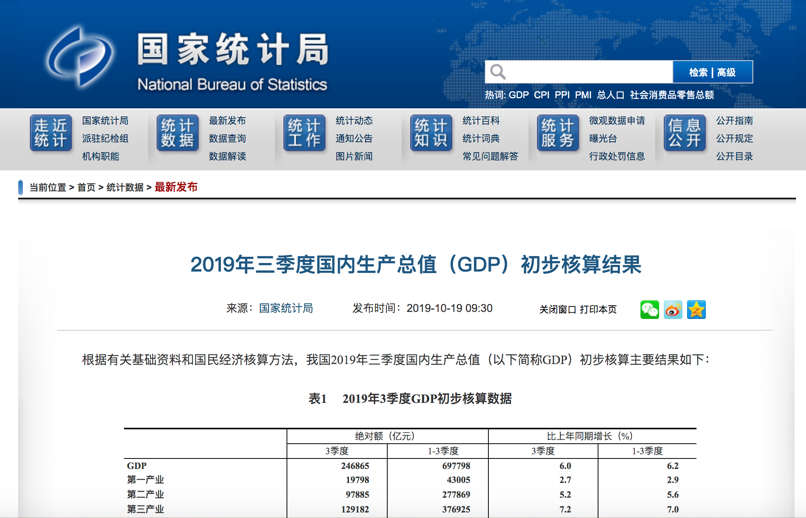
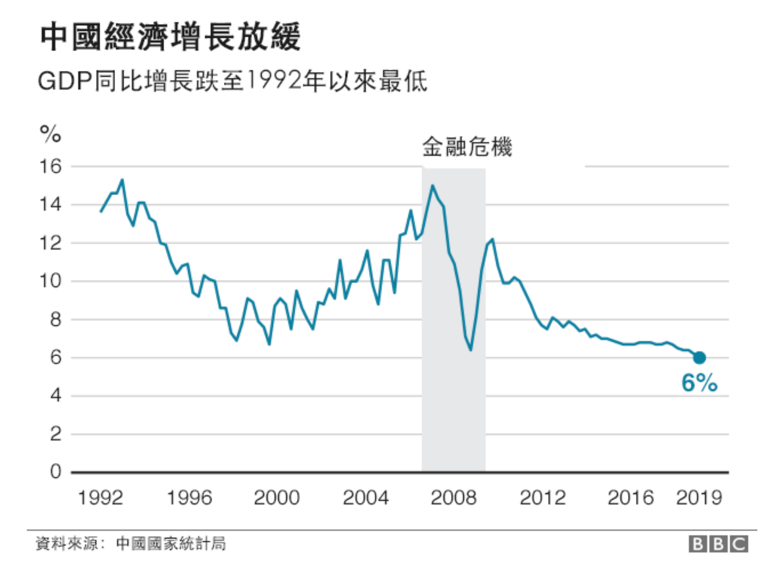
China’s economy currently faces a downturn unlike anything it has faced in the past several decades. We now see the term “Six Steadies” (六稳) being used as a provisional response to this weakness – the next conditioning of the public to lower expectations. The goal now, in other words, is holding the line in terms of employment, investment and so on. Use of the term “Six Steadies” was 2.8 times higher in Chinese newspapers in 2019 (based on the Qianfang database) than in 2018.
Among the six priorities outlined in the “Six Steadies” formula, we saw “steady expectations” leading in 2018. In 2019, the clear priority seems to be “steady employment,” which shows quite a dramatic rise over the past two years.

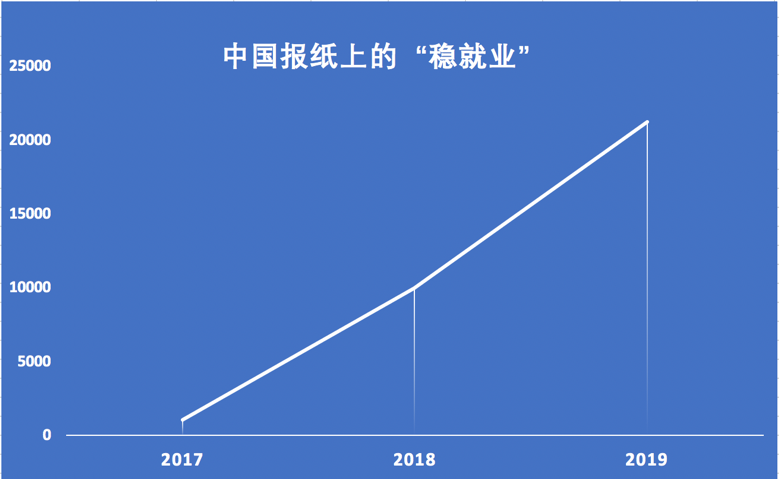
The release just last month by the State Council of “Opinions Concerning Further Stabilizing Employment Work” (关于进一步做好稳就业工作的意见) can be read as a further sign of just how serious the issue of employment has become for the leadership.
The announcement of the State Council document took prime position in the People’s Daily on Christmas Day, appearing right next to the newspaper’s masthead.

The full text in Chinese of our 2019 political discourse report is included below, including a discussion of what I call the “442 Formula,” referring to the “Four Consciousnesses,” “Four Confidences” and “Two Protects,” which warmed up toward the end of the year, along with increased talk of Xi Jinping as the “people’s leader” (人民领袖) — a direct result of the reformulating of the “442” formula.
You will also find a more in-depth discussion of the phrase “political system reforms,” which as I said at the outset seems very much to be on its way out.
_________________
中国语象2019
钱 钢
2019,中国政治最重要的话语现象,是有40年历史的“政治体制改革”被停用。中国政改由邓小平、胡耀邦、赵紫阳启动,1986、1987、1988三年,该语在人民日报的语温达到“热”级,成为1987年中共13大的主题。之后趋冷,18大后词频速降,直至从体制改革话语体系中被正式剔除。
沸语烫词
使用中国传(CMP)媒研究计划的中国党媒语温方法观测,2019人民日报上主要政治语汇的语温如图:
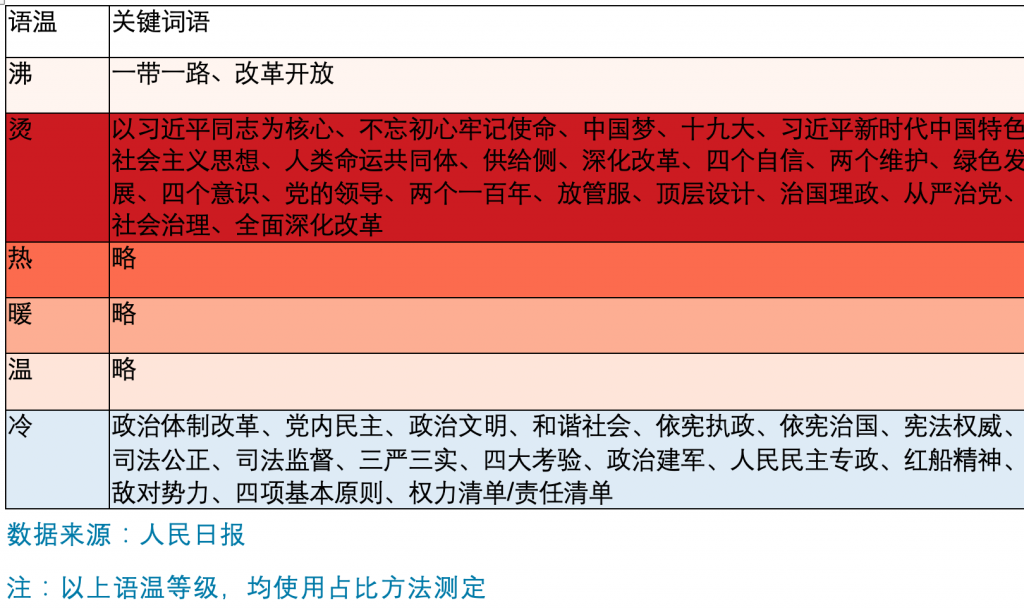
和2018相比,总格局变化不大。2019的沸级词语有两个:“一带一路”,“改革开放”。2018四个沸词中的另两个,“十九大”和“习近平新时代中国特色社会主义思想”,2019降为烫级。
2019的烫词,新增了“两个维护”和“不忘初心,牢记使命”。“两个维护”,2018年秋和“四个意识”、“四个自信”一起成为党报规范用语。“不忘初心,牢记使命”是2018年热语,2019随着同名教育活动在中共全党展开,升级为烫。
2019,从2018烫词中下降一级转为热词的有“乡村振兴战略”、“创新驱动”和“依法治国”。
2019新增冷词有:“政治文明”(从暖降两级)、“依宪治国”(从暖降两级)、“宪法权威”(从暖降两级)、“权利清单/责任清单”(从暖降两级)。
“敌对势力”是2019冷词,这不意味着此类表述减少。2019有另一个同义词“外部势力”,下半年被频繁使用,年度语温为热。
观语经济
2019,中国经济怎么样?请看语象:
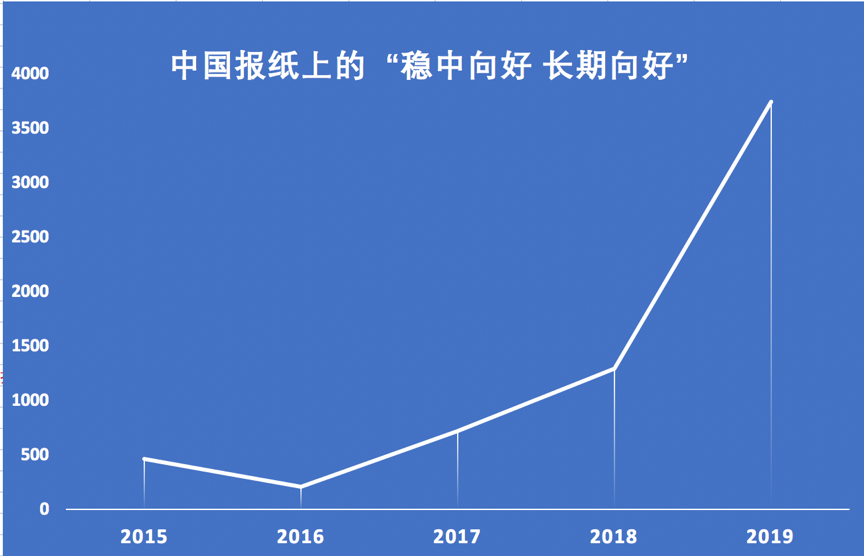
中国经济“稳中向好、长期向好”的语词频率,2019飙升。这是当局的描述。国民生活感受中,另有一字飙升:
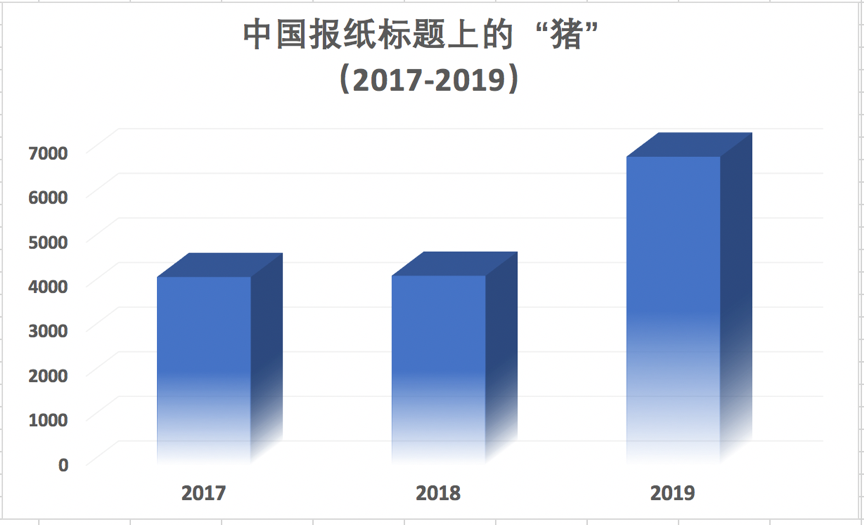
这个上行趋势由负面消息拉动。猪肉市场的震荡,虽是经济运行个别事件,但无疑是2019年政府的一块心病,拆了“稳”与“好”的台。
判断中共19大后的宏观经济形势,可以观测关键词“下行压力”。这个词语在2015年曾出现传播高峰,后滑落,最近3年的变动趋势如图:

每年年底的中央经济工作会议,均有重要信息。2012以来,8次会议的关键词语是:
2012:“全面深化经济体制改革”;
2013:“稳中求进”;
2014:“新常态”;
2015:“供给侧”;
2016:“新发展理念”;
2017:“防范化解重大风险”;
2018:“稳就业、稳金融、稳外贸、稳外资、稳投资、稳预期”(简称“六稳”);
2019:“稳字当头”;
纵观8次会议,乐观情绪逐年降低,危机感递增。“中国经济新常态”是在GDP落到8%以下时提出的,意在使国人接受7%-8%增长的现实;“供给侧结构性改革”,是振衰起弊的应对之道,试图重拾动力。“新常态”和“供给侧”,提出后皆成党媒烫词。但2019的传播显出疲态:
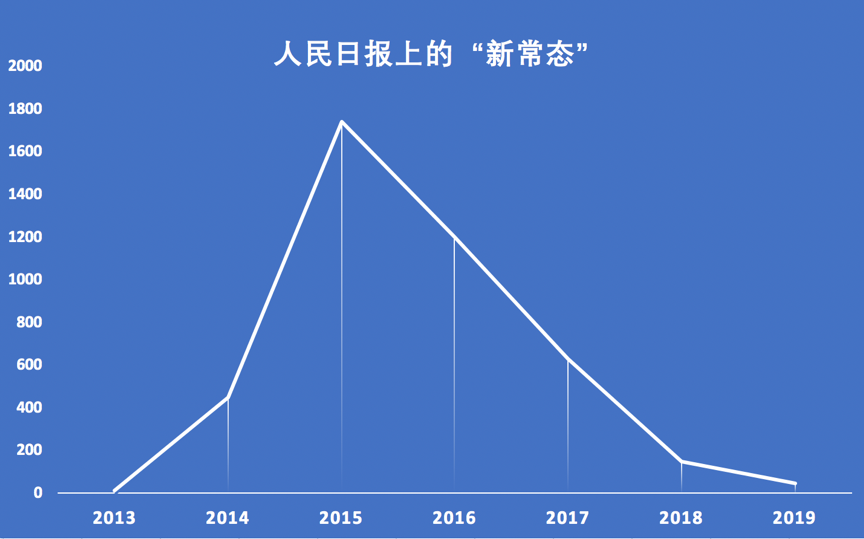
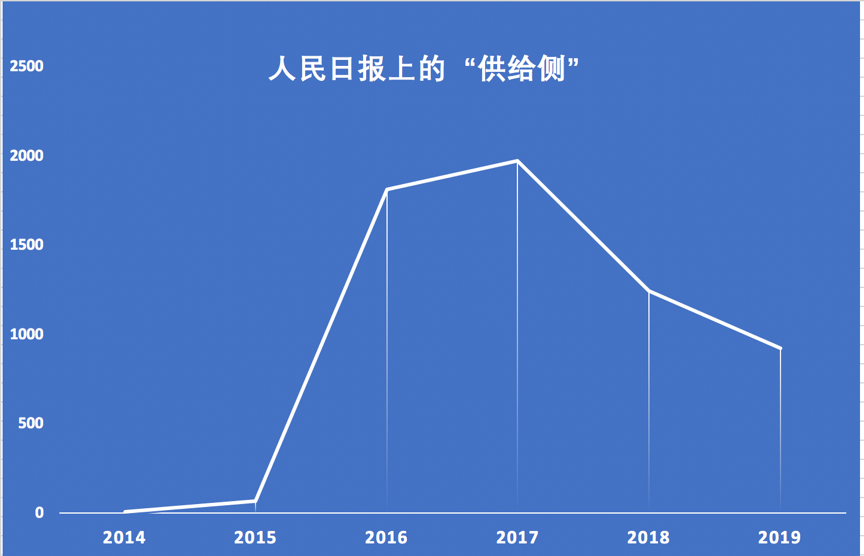
2019,引领中国经济的两个重要关键词,“供给侧”还维持烫级,但比2017减少了一半传播量;因为7%-8%的经济“新常态”已经改变,“新常态”落到暖,接近冷。
2019年10月19日,国家统计局公布第三季度GDP核算结果,引起世界关注:


中国经济面临空前的下行压力。“六稳”是应急反应。2019,中国报纸上使用“稳就业,稳预期,稳投资,稳外贸,稳外资,稳金融”的文章篇数是2018的2.8倍。
“六稳”的排序,2018“稳预期”为首,2019首位是“稳就业”,该词频率连年上升。
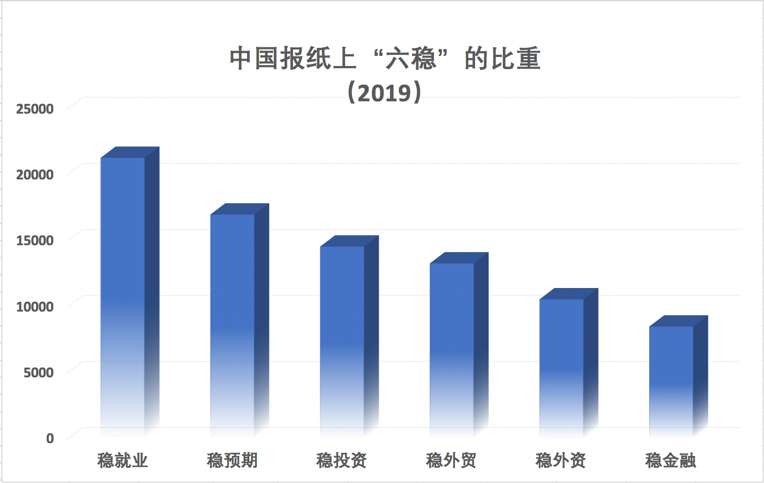

2019年年底,国务院印发《关于进一步做好稳就业工作的意见》,可见就业问题的严峻。

值得注意的是,“六稳”中“稳金融”殿后,可印证下面的曲线:
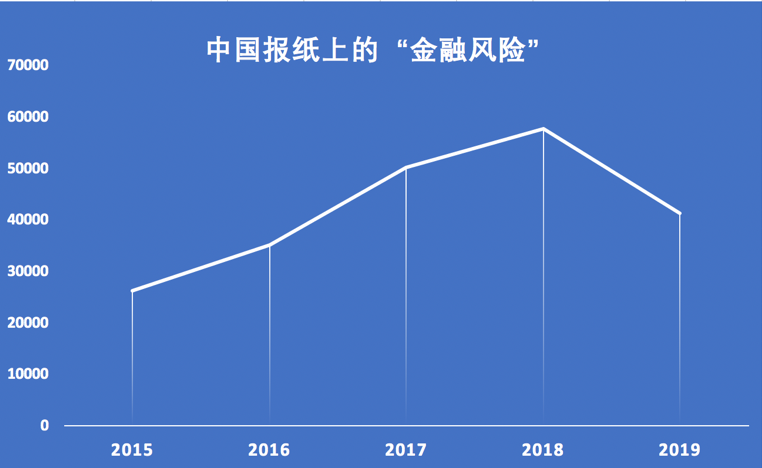
这有可能从一个侧面说明金融改革的效果。“金融供给侧结构性改革”一语,2019有较大力度的传播:

中国正从科技创新中寻找经济发展的新动能。笔者关注2015以来的3个关键词:“量子通信”、“5G”、“区块链”,发现“量子通信”的传播在2017登峰后降温,“5G”和“区块链”连年上升,2019,“5G”甚至有大跃进之势。

首秀和剧终
2019,中国政治词典增加了许多新语句,它们的首秀,在19届4中全会。包括:
“中国特色社会主义制度的根本制度、基本制度、重要制度”;
“到我们党成立一百年时,在各方面制度更加成熟更加定型上取得明显成效;到二〇三五年,各方面制度更加完善,基本实现国家治理体系和治理能力现代化;到新中国成立一百年时,全面实现国家治理体系和治理能力现代化”;
“健全总揽全局、协调各方的党的领导制度体系”;
“建立不忘初心、牢记使命的制度”;
“完善坚定维护党中央权威和集中统一领导的各项制度”;
“健全党的全面领导制度”;
“健全提高党的执政能力和领导水平制度”;
“坚持马克思主义在意识形态领域指导地位的根本制度”;
“党委领导、政府负责、民主协商、社会协同、公众参与、法治保障、科技支撑的社会治理体系”;
“建立健全特别行政区维护国家安全的法律制度和执行机制”。
笔者用语象方法分析19届4中全会通过的1.8万字的《中共中央关于坚持和完善中国特色社会主义制度 推进国家治理体系和治理能力现代化若干重大问题的决定》,发现一个重要的词语已经寿终正寝:“政治体制改革”。
中共19届4中全会的核心议题是制度。决定用了“国家制度”、“党的领导制度”、“国家治理体系”等词语来表述制度。决定提到的制度,虽然从政治、经济、文化到社会、民生、生态包罗万象,但核心是政治制度。决定所说的“坚持党的领导、人民当家作主、依法治国有机统一”是中共使用多年的术语,原本是对政治体制改革的规范性要求。决定第二、三、四条提出的“坚持和完善党的领导制度体系,提高党科学执政、民主执政、依法执政水平”、“ 坚持和完善人民当家作主制度体系,发展社会主义民主政治”和“坚持和完善中国特色社会主义法治体系,提高党依法治国、依法执政能力”,即上述的“三者有机统一”。
然而,全文没有“政治体制改革”一词。
我们可以对比18大以来的几个重要讲话和文件:1,2013年18届3中全会通过的《中共中央关于全面深化改革若干重大问题的决定》。2,2017习近平19大报告。3,2018年12月18日习近平《在庆祝改革开放40周年大会上的讲话》。这三个文本,均使用了“政治体制改革”一语。
从19届4中全会的议题和“决定”的论述重点看,“政治体制改革”原本无法回避。整个决定文本中,“改革”一词出现了27次,其中有5个“体制改革”: 行政执法体制改革、文化体制改革、医药卫生体制改革、国防动员体制改革、纪检监察体制改革。这么多的“改革”和“体制改革”,为什么偏偏遗漏了“政治体制改革”?
这只能说明,这个词语在“习近平新时代”已不合时宜,中共已决心弃用(不排除日后在历史叙述时少量出现)。
从1985到2019,“政治体制改革”在人民日报上留下的印记如图:

词语如有墓碑,可将此图勒石。
“442”跟进
2018上半年,赞颂领导人的标配语“全党拥护,人民爱戴,当之无愧”(以及“忠诚核心,拥护核心,维护核心,捍卫核心”和“党的核心,军队统帅,人民领袖”)被调控降温,代之而起,是年底前升温的“增强‘四个意识’、坚定‘四个自信’、做到‘两个维护’”,笔者简称“442”。2019,人民日报上该语温度为烫。


观察2019各季度中国报纸和各月人民日报,可以看到“442”的传播有“两头高,中间低”的现象。人民日报显示,年底对“422”发动了新的宣传攻势。
“442”,重点是“2”;“2”,重点是“维护习……地位”。“维护”的反面容易理解,然而,2019年初,中共中央发布“关于加强党的政治建设的意见”,在专门论述“两个维护”时指出了另一种“错误言行”。它强调:“不得搞任何形式的‘低级红’、‘高级黑’,决不允许对党中央阳奉阴违做两面人、搞两面派、搞‘伪忠诚’”(人民日报2019.2.28)。
“低级红、高级黑”,恐令大批官员尴尬。“意见”发布后,截至2019年底,人民日报仅2篇文章使用这个词语。网络上有对“高黑低红”的批评,不过只是列举了先进人物宣传中的夸张现象(如宣传一位女干警为加班“28天不洗头不换衣”、“扶贫干部和女贫困户结婚”等),和“两个维护”扯不上关系。
和2018相比,2019人民日报对领袖的宣传明显谨慎。最接近2018上半年“标配语”的是下面作者署名“宣言”的这段话:
坚定的理想信念,高超的政治智慧,“以身许党许国”的担当,“我将无我,不负人民”的赤诚……在“四个伟大”的壮阔实践中,习近平总书记成为党的核心、人民领袖,众望所归,当之无愧。认定主心骨、压舱石、定盘星,坚持统一思想、统一意志、步调一致,面对再大的惊涛骇浪,我们都能从容不迫,自信坚定。(人民日报,2019.9.28)
地方党媒和军报对“442”尤其是“2”各有发挥,如:
“忠诚核心、维护核心、看齐核心、追随核心”(重庆,2019.11.22,武隆报)。
“将维护核心、拥戴核心、追随核心内化于心、外化于行”( 江西,2019.11.22,赣南日报)。
“把拥戴核心、追随核心作为最大的政治。同心共向、同频共振、同轴共转”(山西,2019.10.29,潞城新闻)。
“政治上坚定拥护核心、思想上高度认同核心、行动上坚决追随核心、组织上自觉维护核心、情感上衷心爱戴核心”(四川,2019.2.15,凉山日报)。
“一切重大事项由习主席决定、一切工作对习主席负责、一切行动听习主席指挥”,“做到习主席提倡的坚决响应、习主席决定的坚决执行、习主席禁止的坚决不做”(2019.3.12,解放军报)。

西藏编印了《习近平总书记重要论述100句》《习近平总书记经典语句摘编》等藏汉双语学习资料,“引导农牧民群众‘村规民约用语录、化解矛盾服语录、生产生活依语录、乡村振兴靠语录’,让习近平总书记人民领袖的光辉形象根植各族群众内心深处”(西藏日报,2019.11.3)。
“两个维护”是中国最大的政治。中央政治局委员、中办主任丁薛祥在四中全会后撰文称:
“两个维护”有明确的内涵和要求,维护习近平总书记核心地位,对象是习近平总书记而不是其他任何人;维护党中央权威和集中统一领导,对象是党中央而不是其他任何组织。党中央的权威决定各级党组织的权威,各级党组织的权威来自党中央的权威,“两个维护”既不能层层套用,也不能随意延伸。(人民日报,2019.11.18)
与丁薛祥的“是……而不是”异曲同工,政治局委员、中宣部长黄坤明赞颂习思想的句式是“只有……而没有”:
实践已经证明并将继续证明,只有这一思想而没有别的什么思想能够引领当代中国发展进步、指引人民创造美好生活,只有这一思想而没有别的什么思想能够凝聚近14亿中国人民的意志、汇集全体中华儿女的力量。
临近2019年末,中共中央政治局召开专题民主生活会。会议如何发扬民主,党媒语焉不详。报道的重点在此:
会议强调,维护习近平总书记党中央的核心、全党的核心地位,维护党中央权威和集中统一领导,是推动新时代中国特色社会主义不断发展前进的根本政治保证。面对当今世界百年未有之大变局,面对错综复杂的国内外风险挑战,习近平总书记高瞻远瞩、统揽全局、运筹帷幄、指挥若定,作出一系列重大科学判断,提出一系列重大战略策略,推动一系列重大工作,领导全党全国各族人民在进行具有许多新的历史特点的伟大斗争、推进新时代中国特色社会主义发展上取得新的重大成就,展现了共产党人坚定的理想信念、人民领袖深切的为民情怀、马克思主义政治家高超的政治领导艺术。(2019.12.28,人民日报)
这是有关“442”的最新表述,将引领2020的领袖宣传。
区域温度
最近两年,我们每月观测中国大陆各省、自治区、直辖市党委机关报,关注政治传播的热度分布。如2018年,做过关键词“定于一尊,一锤定音”的语温地图。
2019,我们选择6组词语进行观察:“不忘初心,牢记使命”、“维护习近平”(这个动宾结构带出的惟一句子是“维护习近平总书记党中央的核心、全党的核心地位”)、“党政军民学,东西南北中”(该语带出的惟一句子是“党政军民学,东西南北中,党是领导一切的”)、“人民领袖”、“全党拥护,人民爱戴,当之无愧”、“高举习近平新时代中国特色社会主义思想伟大旗帜”,结果如下:
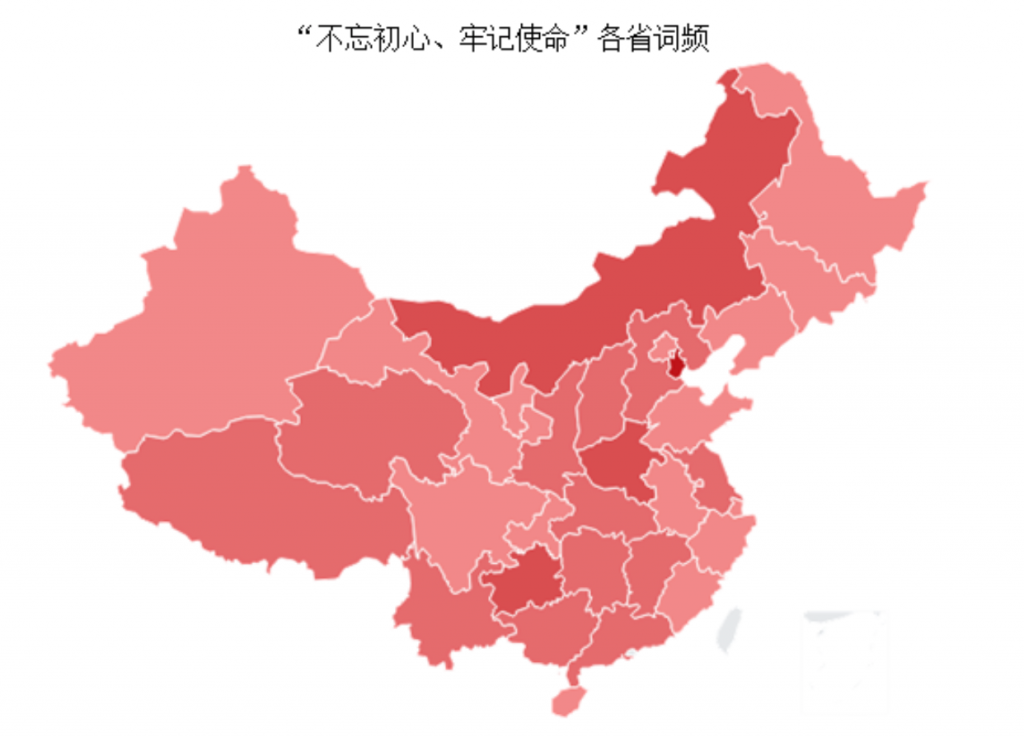
“不忘初心,牢记使命”,传播热度最高的前三位是:天津,贵州,河南;后三位是:上海,四川,安徽。
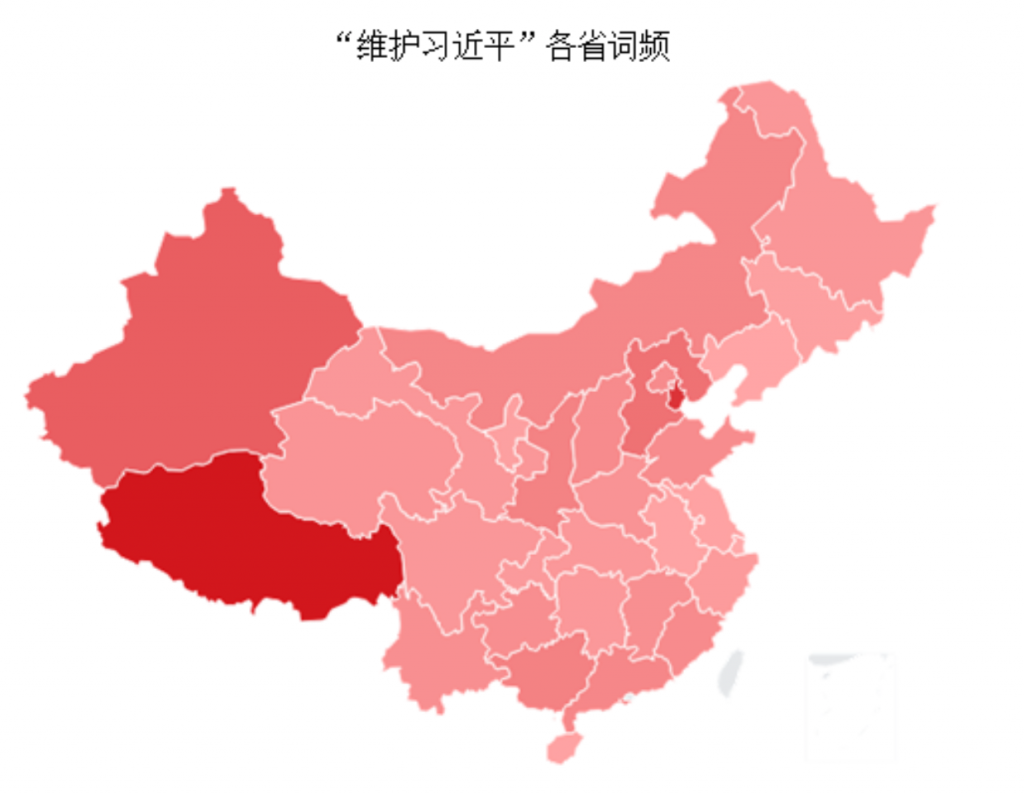
“维护习近平”,传播热度最高的前三位是:西藏,天津,新疆;后三位是:上海,辽宁,安徽。
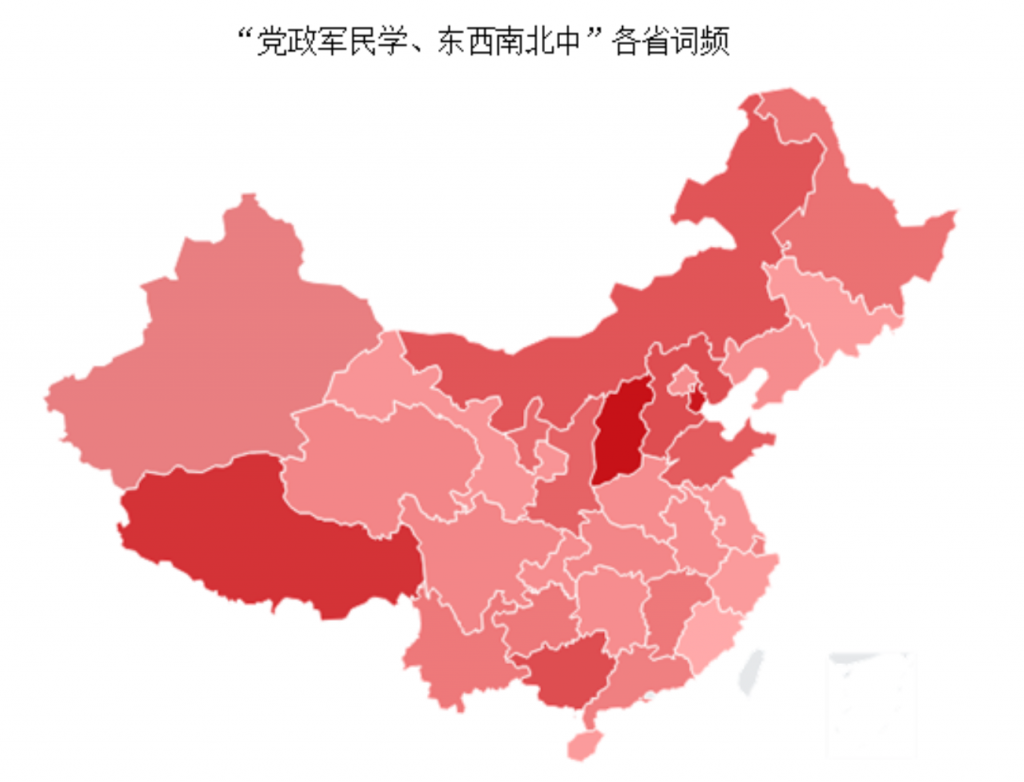
“党政军民学,东西南北中”,传播热度最高的前三位是:山西,天津,西藏;后三位是:福建,浙江,吉林与海南(并列)。
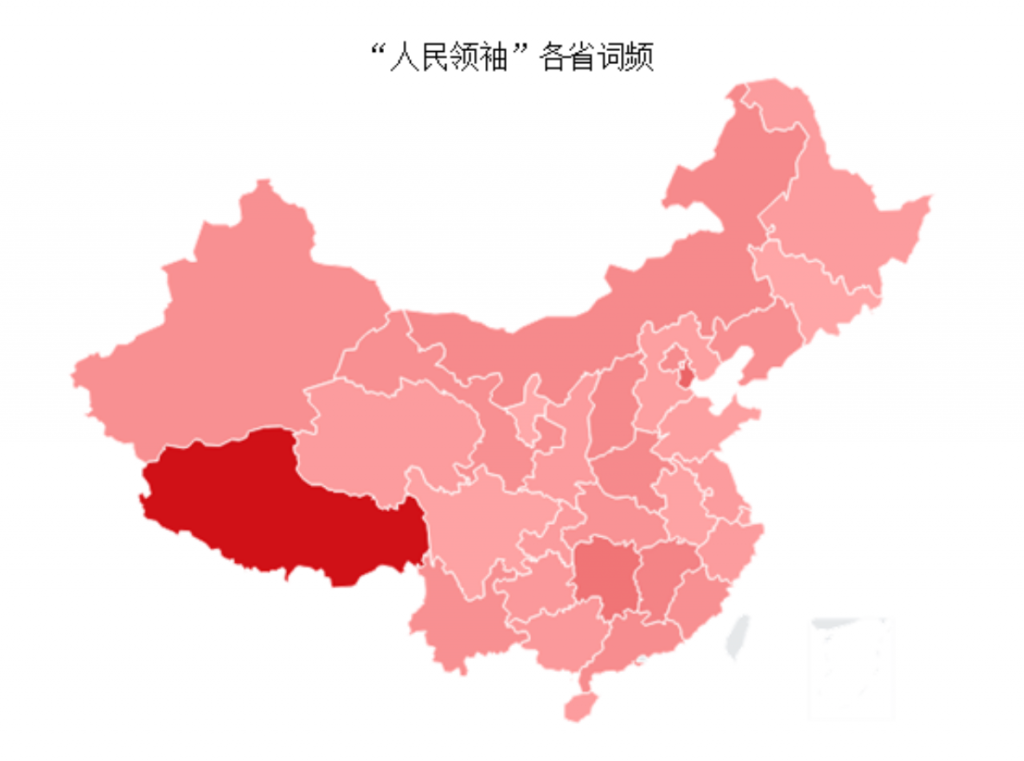
“人民领袖”,传播热度最高的前三位是:西藏,天津,湖南;后三位是:宁夏,吉林,安徽与上海四川(并列)。

如前所述,“全党拥护,人民爱戴,当之无愧”一语,2018已调控降温,2019,仅三地使用:西藏,广东,江西,西藏次数最多。
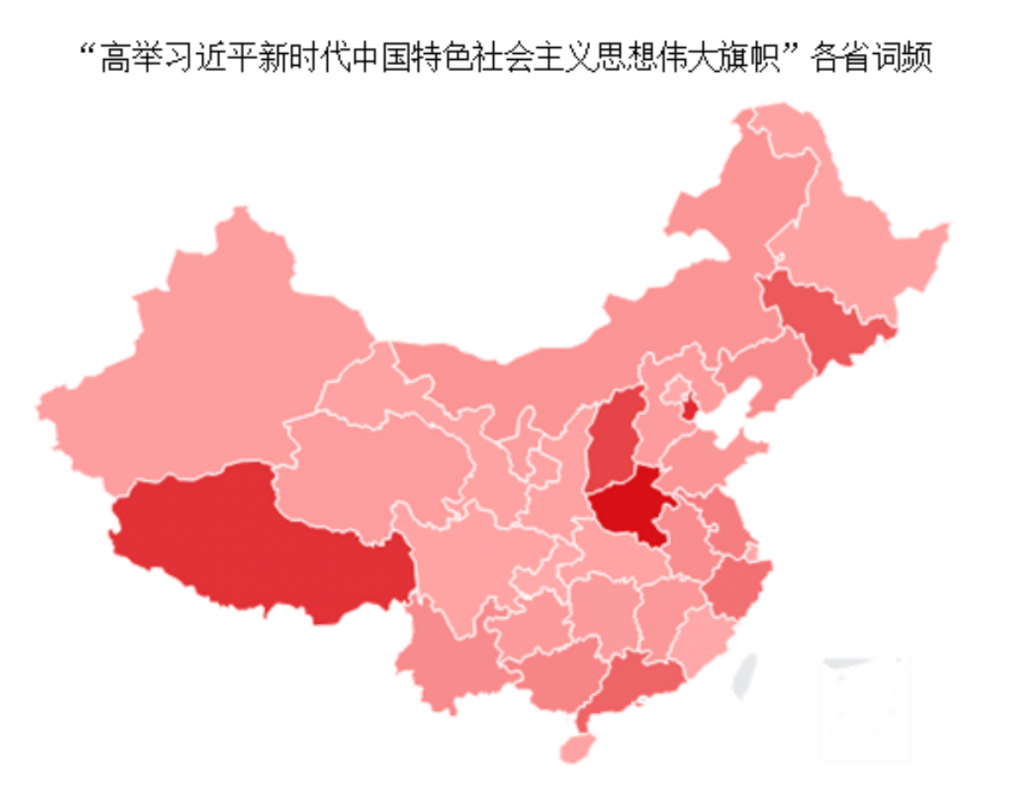
“高举习近平新时代中国特色社会主义思想伟大旗帜”,是个蓄势待发的语句(下文将分析)。传播热度最高的前三位是:河南,天津,西藏;后三位是:重庆,上海,北京。
对这6组词语的传播,热度明显领先的是西藏(包括使用了“全党拥护……”,在5组名列前三,而且有三个第一:“维护习近平”、“人民领袖”和“全党拥护……”)和天津(除了中央已调控降温的“全党拥护……”,其余5组都名列前三)。
进入后三位次数最多的是上海(4次)和安徽(3次)。
细看6组词语的传播,发现较为低调的除了上海,还有重庆和北京。有个耐人寻味的现象:“高举习近平新时代中国特色社会主义思想伟大旗帜”一语,使用最少的,是政治局委员蔡奇、陈敏尔、李强分别担任书记的北京、重庆、上海;但另一位政治局委员李鸿忠主政的天津,热度夺银。
2019,我们逐月观测了各省、自治区、直辖市第一把手在辖区党委机关报的出现频率,排名前三的是:河北王东峰,西藏吴英杰,海南刘赐贵。其中西藏的这项指标和西藏在前面关键词语温地图的排名高度吻合。吴英杰的出现频率有8个月进入前三,3个月排名第一。但天津李鸿忠曝光度不高,2019曾有4个月列入后三。排名最后的是新疆陈全国。
政治口号传播热度和个人曝光度的区域比较,意涵丰富,可供政治学者深入研究。笔者的粗浅判断是:高调或低调,与地方首脑的忠诚、地位的巩固等,没有“正相关”的对应;或可反向解析。
蓄势之“高举”
两年来,笔者一直密切关注“习近平新时代中国特色社会主义思想”向旗帜语完成版“习近平思想”的缩略,并在2018语象报告中判断“缩略速度折射最高权威的强度”。
2019,缩略未完成。2018曾出现的数十种习思想,已基本集中在四个思想即“习近平强军思想”、“习近平外交思想”、“习近平生态文明思想”和“习近平新时代中国特色社会主义经济思想”。这四个思想在2019年的总使用量比2018年小幅提升,比重如图:
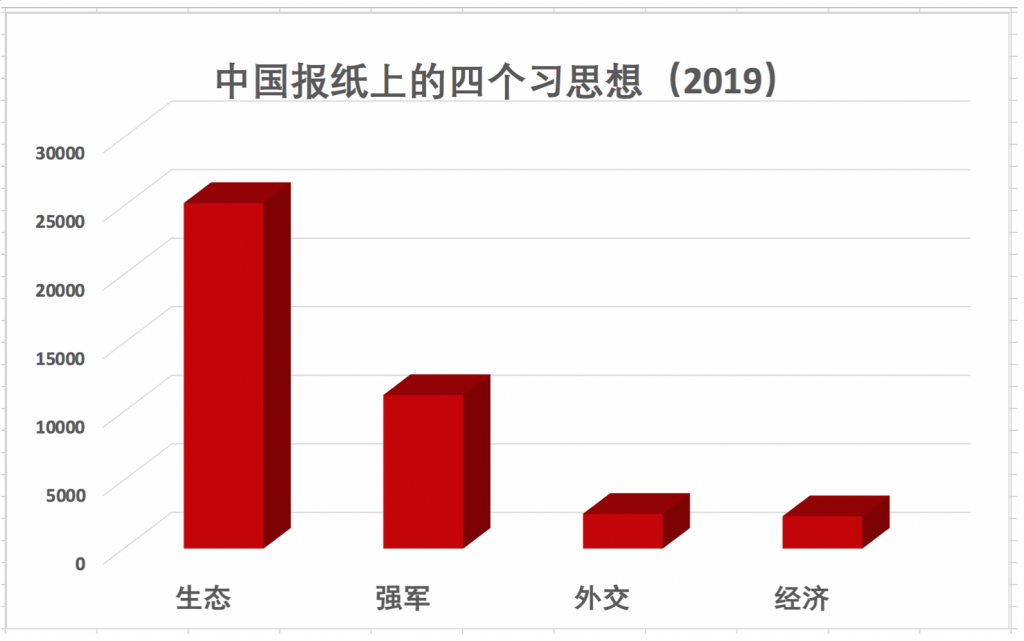
如缩略告成,“习近平思想”将无悬念地被嵌入“高举……伟大旗帜”的句式中。这是中共话语仪式中的最高级形态,曾应用于“毛泽东思想”和“邓小平理论”。然而笔者发现,缩略尚待完成,“高举”已然出现。
2017年秋,19大上,军委副主席许其亮提出“高举习近平新时代中国特色社会主义思想旗帜”;军委委员魏凤和的讲话多了修饰词“伟大”。大会闭幕后不久,浙江将“高举习近平新时代中国特色社会主义思想伟大旗帜”写入了省委决定。
这一语句极为重要。19大后的共青团18大、工会17大、妇联12大上,这句话都写在人民大会堂二楼眺台上。奇怪的是,这两年在党媒上,它还远不是热语。
这种情况在历史上曾有过。
“高举毛泽东思想伟大红旗”在党报首次出现,是在1963年底。军方是该语传播的力推者。1964,解放军报上它的语温为“热”,人民日报上为“冷”。
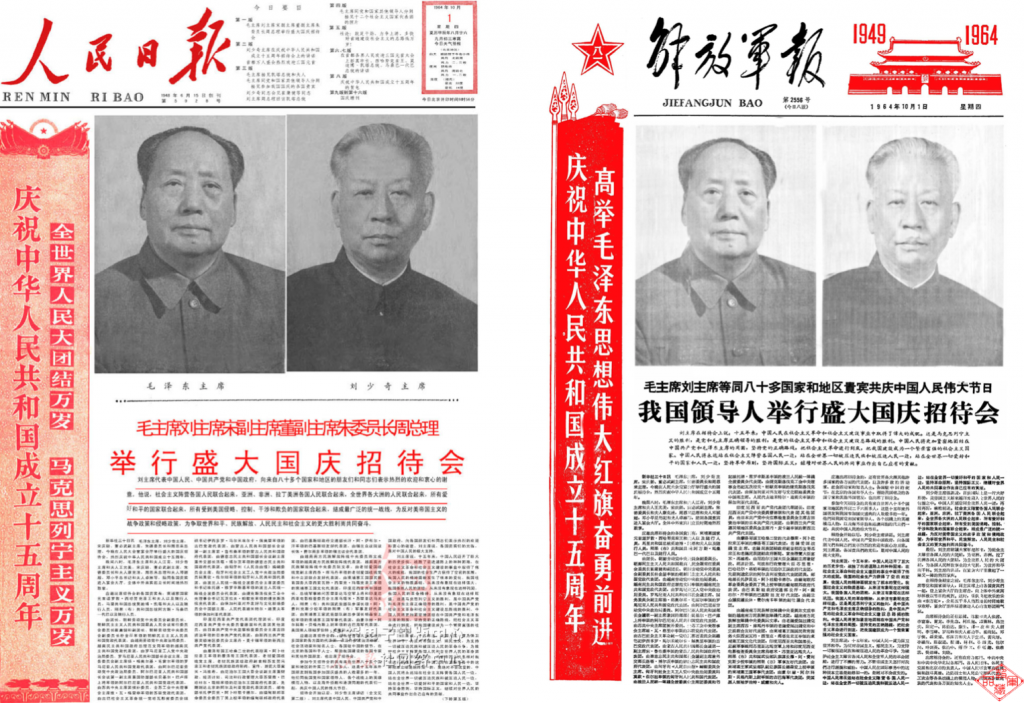
1964年国庆,军报和人民日报的头版刊登的领袖像和报道完全一样,大标语却不同。解放军报使用了“高举毛泽东思想伟大红旗”,人民日报却没有。1965,军报上该语为“烫”,人民日报达到了“热”(国庆头版和军报一样使用了“高举”标语)。1966,两报上该语都升腾为“沸”。文革开始。如雷贯耳的“高举”声中,上图左边党主席“光焰无际”,右边国家主席成为“叛徒、内奸、工贼”。鉴之历史,颂词隐藏的杀机让人不寒而栗。
“高举毛泽东思想伟大红旗”的生命周期为13年(1963-1976)。接下来的“高举邓小平理论伟大旗帜”,生命周期为16年(1997-2012)。它的声势不如前者,在人民日报上从未达到沸级。1997年,江泽民“5.31讲话”首秀此语,1997下半年,语温为烫。1998-2002,各年语温降为热(其中2000年为暖)。2003-2007,总体降到温。2008-2012,降为冷。
“高举邓小平理论伟大旗帜”后,零星出现过“高举‘三个代表’重要思想伟大旗帜”(习近平在浙江省委书记任上曾在报刊文章上使用)、“高举‘科学发展观’伟大旗帜”。江泽民和胡锦涛的旗帜语,冠名都不可能,“高举”焉能奢望。
“高举习近平新时代中国特色社会主义思想伟大旗帜”降生已两年,其传播状况可堪玩味。人民日报上,2018,2019,“高举”的语温均为冷,有点像1964。和1964不同的是,并不存在两个声音。19大后,军方对“高举”的推动乏力,两年来解放军报上“高举”的语温不比人民日报高。1965的升温,在2019也未发生。2019的使用篇数与上年相若且略减(全部中国报刊的使用总量也相似)。
这个重要的语句,既没有出现在2018、2019两会的各个报告中,也没有出现在二中、三中、四中全会的公报里。两年来,政治局常委仅两人在公开讲话中对其使用过“高举”(赵乐际,2018.10.30,中国妇女12次代表大会致辞;汪洋,2019.8.29,全国非公有制经济人士优秀中国特色社会主义事业建设者表彰大会的致辞)。下图显示2019人民日报上“习近平新时代中国特色社会主义思想”和“高举习近平新时代中国特色社会主义思想伟大旗帜”的传播比例:
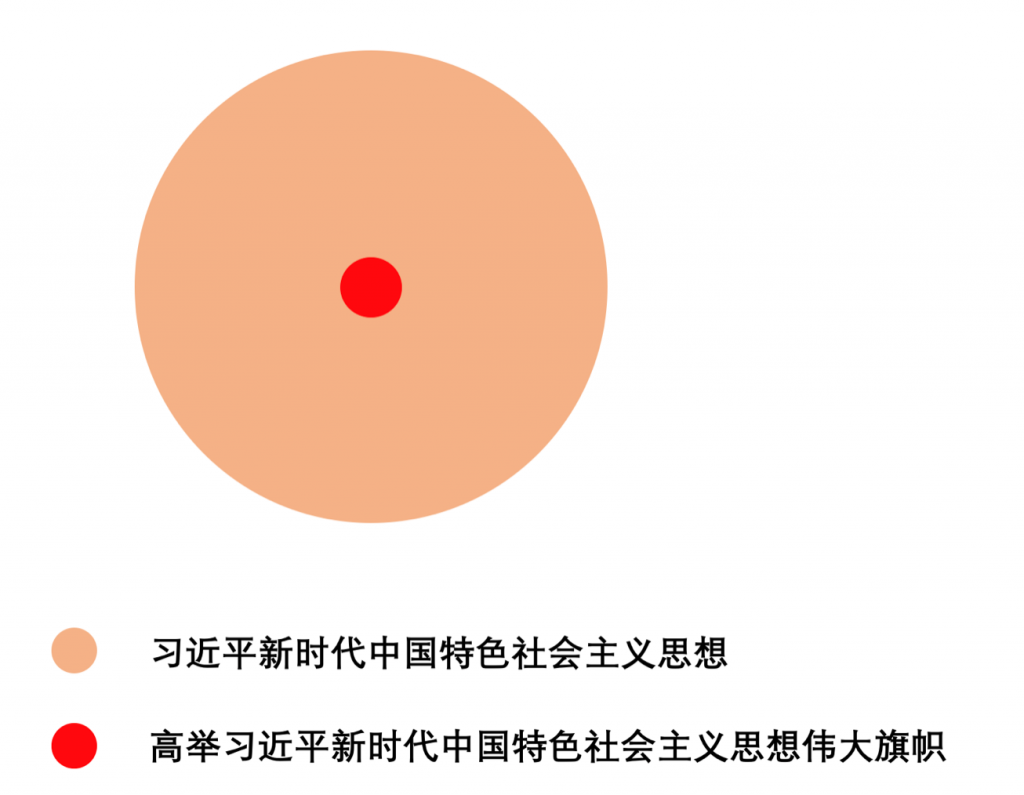
“高举习近平思想伟大旗帜”无疑是终极话语目标。现实表明,攀登峰巅并不轻松。2019是“高举”的蓄能之年。笔者判断,在中共的时间表上,上图中心的红圈,未来将扩大,在2021建党百年纪念日,成为党媒烫级以上话语。而“高举习近平思想伟大旗帜”,应悬挂在2022中共20大会场。
(参与本文数据挖掘的有陶乐思、朱蕴儿、丁丁,特此致谢)




















